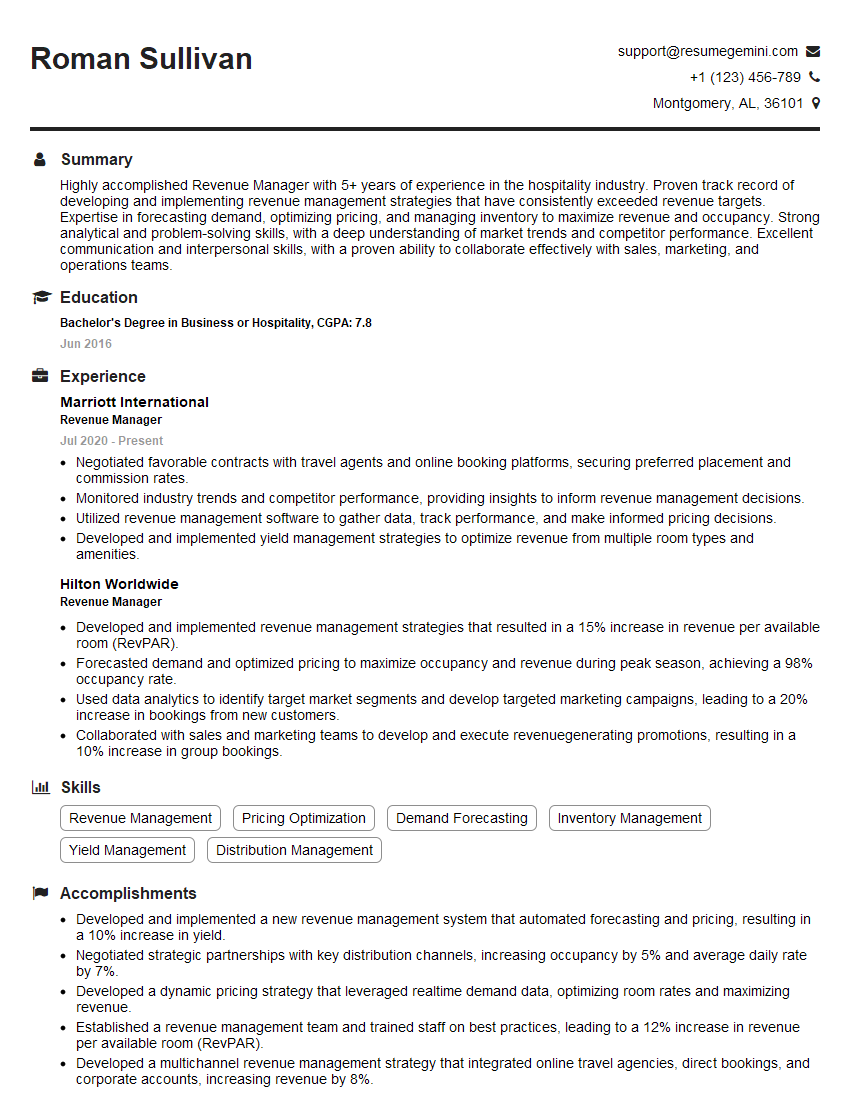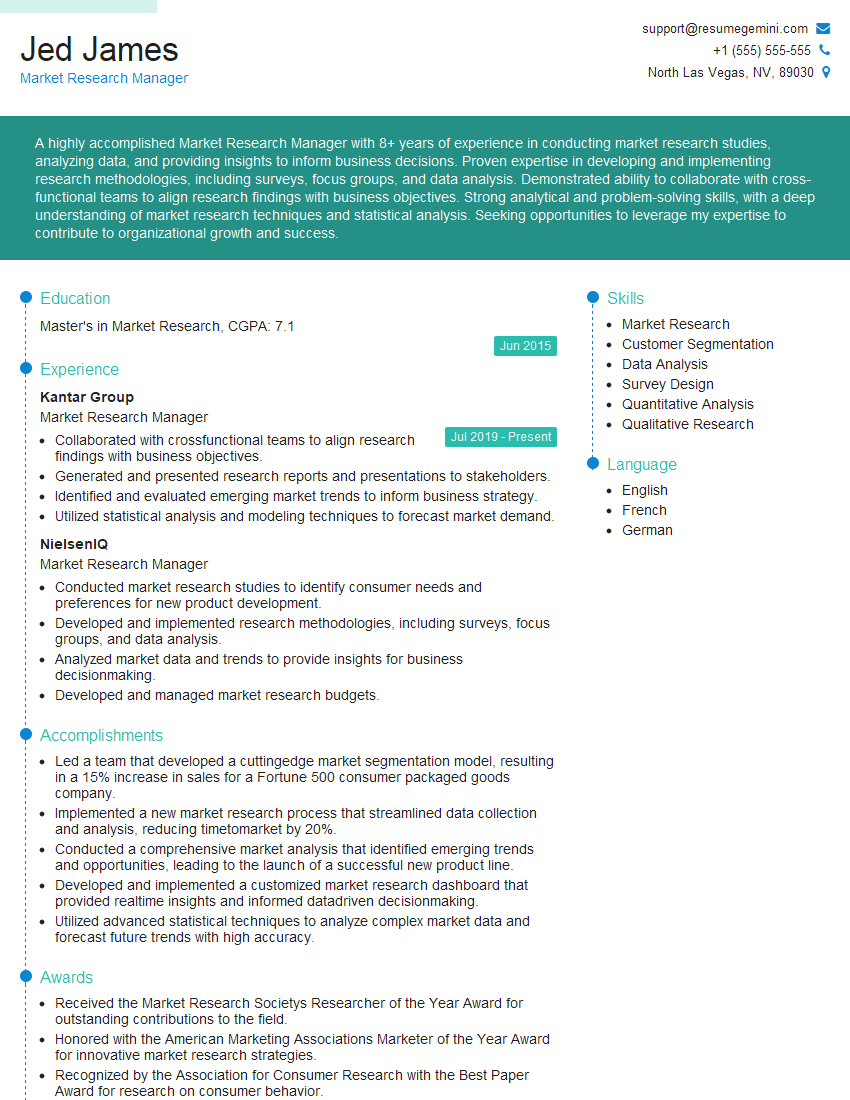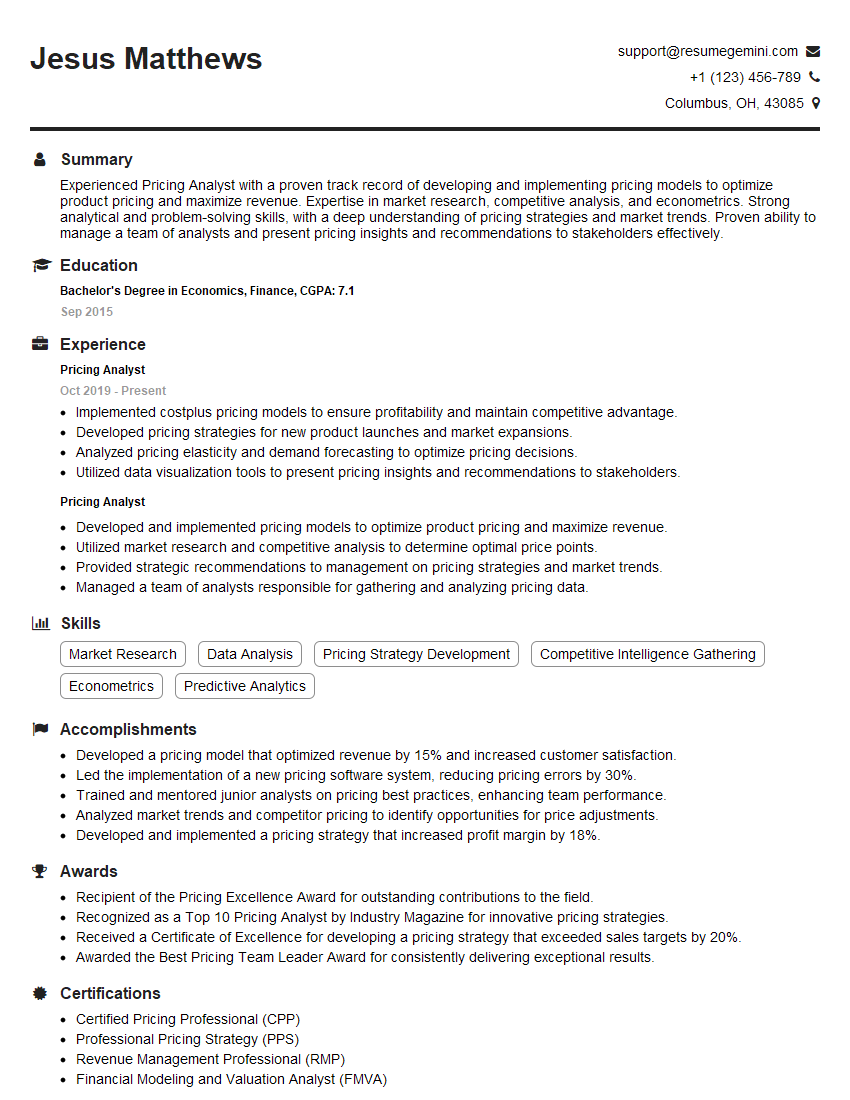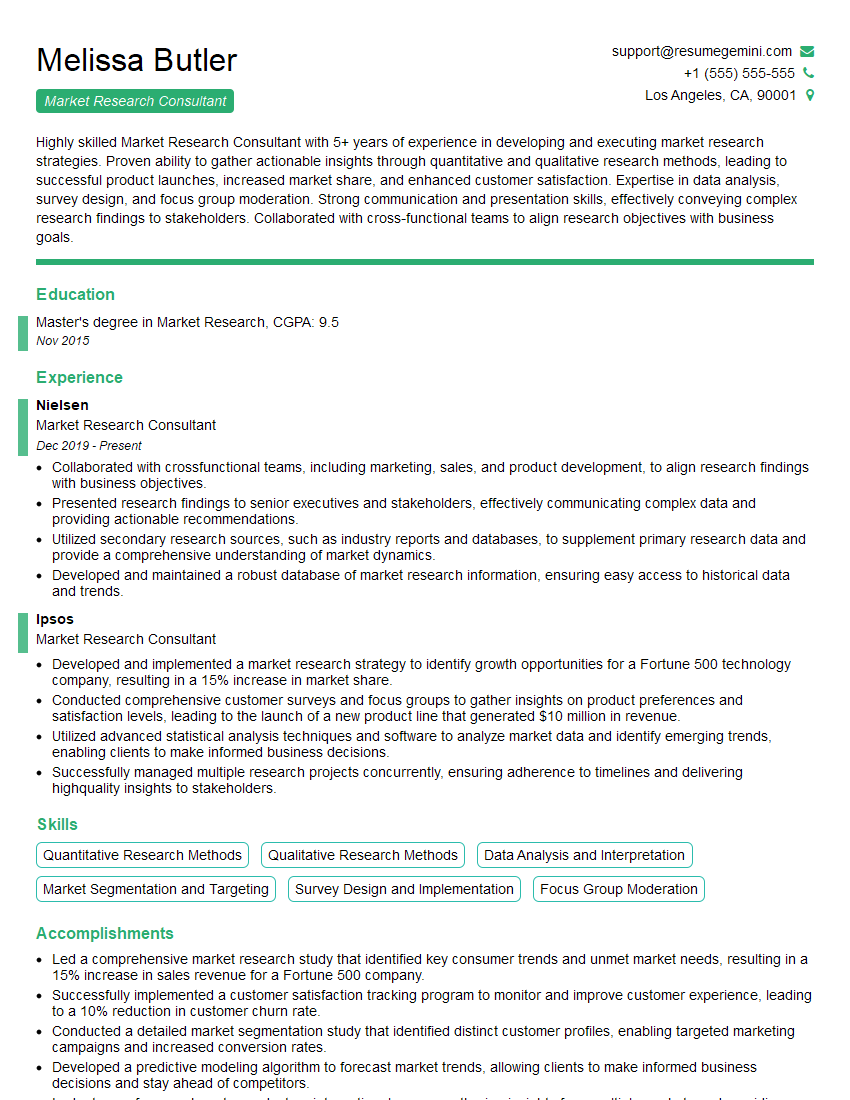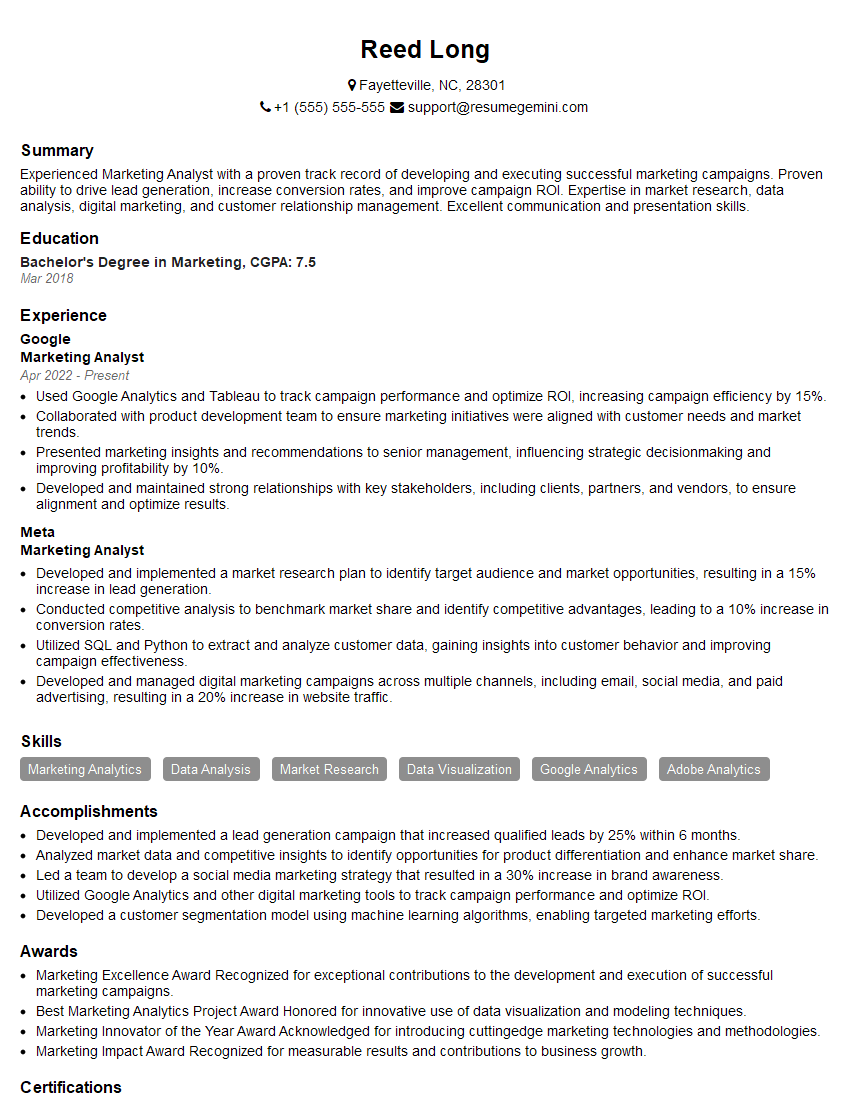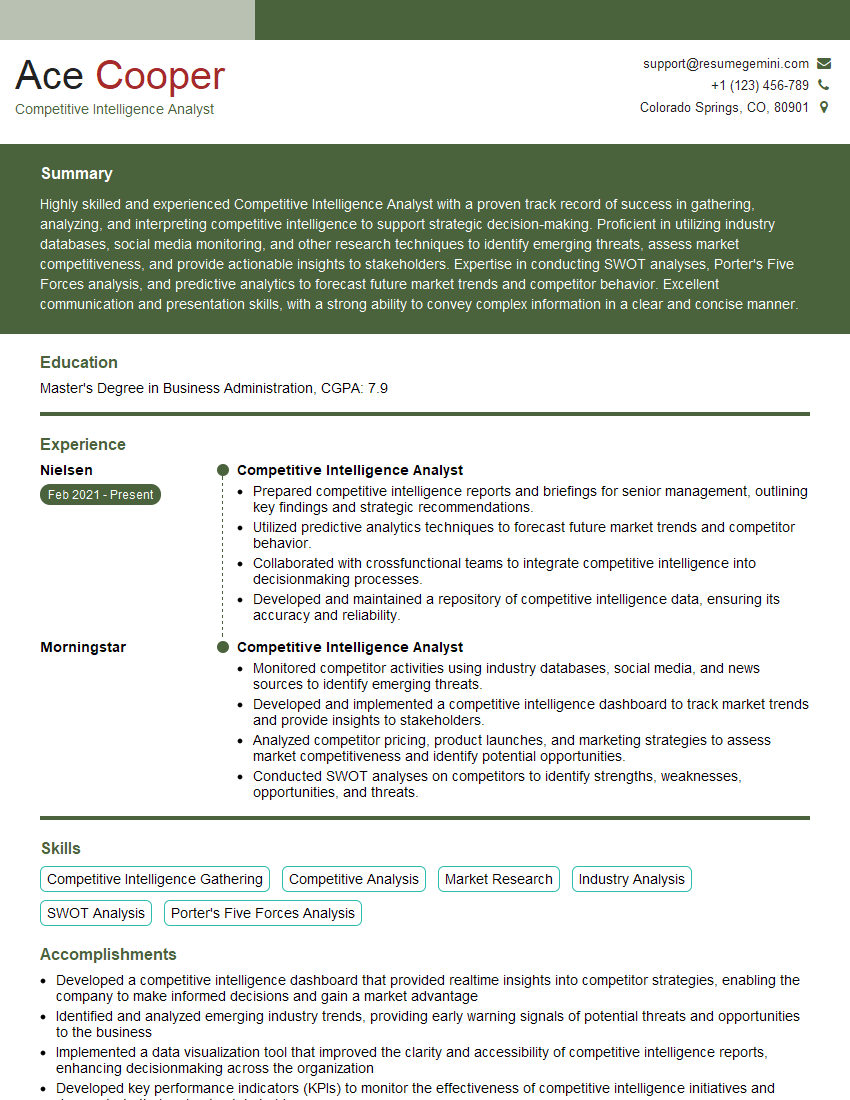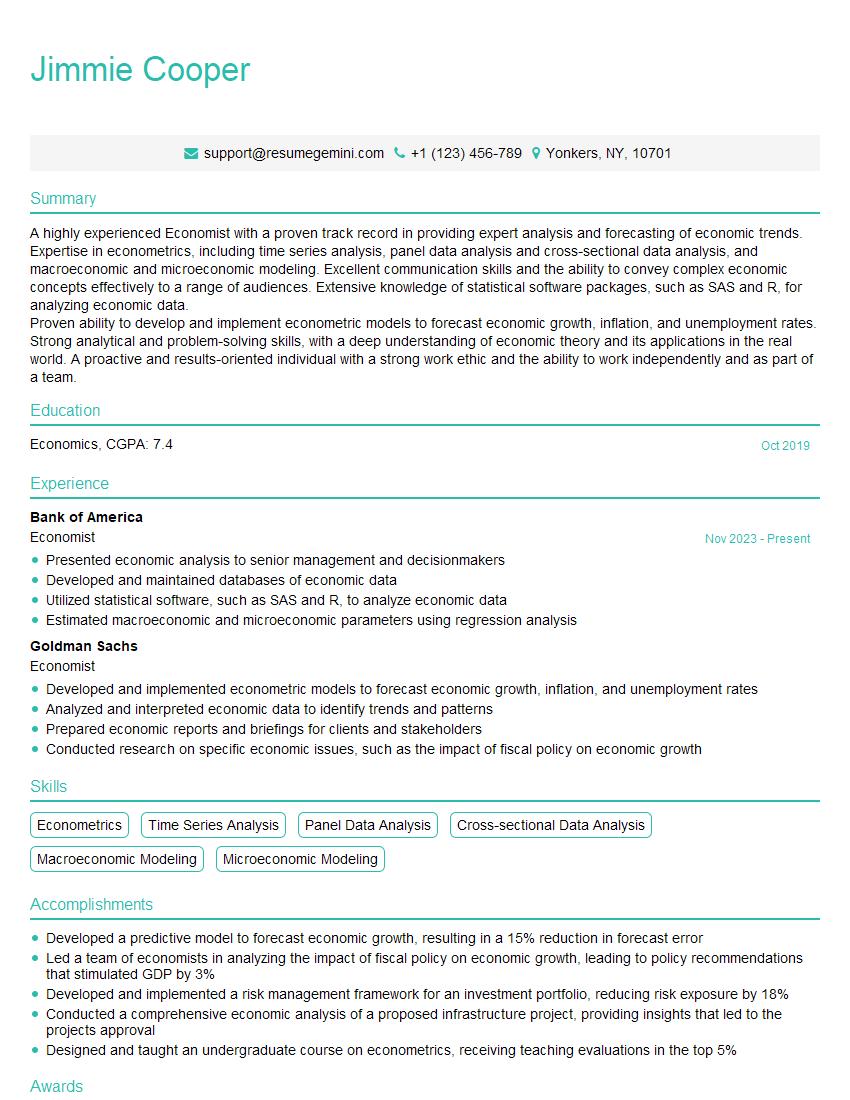Interviews are more than just a Q&A session—they’re a chance to prove your worth. This blog dives into essential Market and Trend Analysis interview questions and expert tips to help you align your answers with what hiring managers are looking for. Start preparing to shine!
Questions Asked in Market and Trend Analysis Interview
Q 1. Explain your understanding of market segmentation and its importance in trend analysis.
Market segmentation is the process of dividing a broad consumer or business market, normally consisting of existing and potential customers, into sub-groups of consumers based on some type of shared characteristics. This allows businesses to tailor their marketing efforts and product development to specific customer needs and preferences, leading to increased efficiency and effectiveness.
In trend analysis, market segmentation is crucial because trends often manifest differently across various segments. For example, a trend towards sustainable products might be stronger among younger, environmentally conscious consumers than among older generations. By segmenting the market, we can identify which segments are adopting trends most rapidly and which are resistant, providing valuable insights for forecasting future demand and strategic planning.
- Geographic segmentation: Dividing the market based on location (e.g., country, region, city).
- Demographic segmentation: Dividing the market based on factors like age, gender, income, education, and family size.
- Psychographic segmentation: Dividing the market based on lifestyle, values, attitudes, and interests.
- Behavioral segmentation: Dividing the market based on purchasing habits, brand loyalty, and usage rate.
Understanding these segments allows for precise targeting of marketing and product development, enhancing the accuracy of trend analysis and predicting future market behavior.
Q 2. Describe a time you identified an emerging market trend. What methods did you use?
During my time at [Previous Company Name], I identified an emerging trend towards personalized fitness technology. I noticed an increase in wearable fitness trackers and mobile apps that offered customized workout plans and nutritional guidance. My methodology involved a multi-faceted approach:
- Social Media Monitoring: I tracked mentions and conversations about fitness tech on platforms like Twitter, Instagram, and Facebook, looking for recurring themes and emerging trends.
- Competitor Analysis: I studied the product offerings and marketing strategies of leading fitness technology companies, looking for new features and initiatives.
- Market Research Reports: I reviewed industry reports from firms like Gartner and IDC, analyzing market size, growth projections, and key drivers of innovation.
- Consumer Surveys: I conducted online surveys and focus groups to understand consumer preferences and attitudes towards personalized fitness technology.
The confluence of these data sources strongly suggested a growing demand for customized fitness experiences, which was later validated by the rapid market growth in this sector.
Q 3. How do you interpret and utilize quantitative and qualitative data in market trend analysis?
Quantitative data provides numerical insights into market trends, while qualitative data offers rich contextual understanding. Both are essential for a comprehensive analysis.
Quantitative data (e.g., sales figures, market share, website traffic) is analyzed using statistical methods to identify patterns and trends. For example, a significant increase in sales of a particular product over time could indicate a growing trend. We use techniques like regression analysis to model relationships between variables and forecasting methods to predict future outcomes.
Qualitative data (e.g., customer reviews, social media comments, focus group transcripts) provides a deeper understanding of the ‘why’ behind the quantitative trends. For instance, analyzing customer reviews might reveal that the increased sales are driven by positive word-of-mouth about a new feature or improved quality. This qualitative context adds nuance and richness to the interpretation of quantitative findings. Techniques such as thematic analysis and sentiment analysis are used to extract meaning from qualitative data.
Ideally, both types of data are integrated. Quantitative data helps identify the *what* and *how much* of a trend, while qualitative data helps explain the *why* and *how* it’s happening. This combined approach provides a more holistic and accurate picture of market trends.
Q 4. What are some common forecasting models used in market trend analysis? Discuss their strengths and weaknesses.
Several forecasting models are commonly used in market trend analysis:
- Time Series Analysis: This involves analyzing historical data to identify patterns and extrapolate them into the future. Methods include moving averages, exponential smoothing, and ARIMA models. Strengths: Relatively simple to implement; requires only historical data. Weaknesses: Assumes that past trends will continue; sensitive to outliers and seasonality.
- Regression Analysis: This statistical technique models the relationship between a dependent variable (e.g., sales) and one or more independent variables (e.g., price, advertising). Strengths: Can identify the impact of different factors on the dependent variable. Weaknesses: Requires a strong understanding of the relationships between variables; can be sensitive to multicollinearity.
- Causal Models: These models attempt to identify and quantify the causal relationships between different factors that influence market trends. Strengths: Provides a deeper understanding of the underlying drivers of trends. Weaknesses: Can be complex and difficult to build; requires a lot of data and expertise.
The choice of model depends on the specific context, the availability of data, and the desired level of accuracy. It’s often best to use a combination of models to improve forecasting accuracy and robustness.
Q 5. How do you evaluate the reliability and validity of market research data?
Evaluating the reliability and validity of market research data is critical. Reliability refers to the consistency of the data, while validity refers to its accuracy and relevance.
To assess reliability, I would consider factors such as:
- Sample size and representativeness: Was the sample large enough and representative of the target population?
- Data collection methods: Were the methods used appropriate and consistent?
- Measurement error: Were there any biases or inaccuracies in the data collection process?
To assess validity, I would consider:
- Construct validity: Does the data measure what it is intended to measure?
- Content validity: Does the data cover all relevant aspects of the topic?
- Criterion validity: Does the data correlate with other relevant measures?
I would also cross-reference data from multiple sources to identify inconsistencies and potential biases. Furthermore, understanding the limitations of the data and acknowledging potential sources of error is essential for a responsible interpretation of the findings.
Q 6. Describe your experience with competitive analysis. How do you identify key competitors and their strengths/weaknesses?
Competitive analysis is a core component of market trend analysis. It helps to understand the competitive landscape, identify opportunities, and anticipate potential threats. My approach involves a systematic process:
- Identifying Key Competitors: This involves defining the market boundaries and identifying all companies offering similar products or services. This may involve analyzing market share data, researching industry directories, and reviewing competitor websites.
- Analyzing Competitor Strengths and Weaknesses: This involves assessing each competitor’s product portfolio, marketing strategies, pricing, distribution channels, and customer base. Techniques include SWOT analysis (Strengths, Weaknesses, Opportunities, Threats), Porter’s Five Forces analysis, and competitive benchmarking.
- Evaluating Competitive Strategies: This involves identifying the strategies each competitor is pursuing (e.g., cost leadership, differentiation, focus) and assessing their effectiveness.
- Predicting Competitor Behavior: Based on the analysis, I would try to predict how competitors might react to changes in the market or new product launches. This helps to inform strategic planning and decision-making.
For example, during a competitive analysis for a new software product, I would assess competitors’ feature sets, pricing models, customer reviews, and marketing spend to understand their strengths and weaknesses, and inform the positioning and pricing of our product.
Q 7. Explain how you would analyze the impact of a specific macro-economic factor on a particular market.
Analyzing the impact of a macroeconomic factor on a particular market requires a structured approach. Let’s say we want to analyze the impact of rising interest rates on the housing market.
- Define the Macroeconomic Factor: Clearly define the specific macroeconomic factor (e.g., interest rate increase of 0.5%).
- Identify the Market: Specify the target market (e.g., residential housing market in a particular region).
- Analyze the Mechanism of Impact: Explain how the macroeconomic factor will affect the market. Higher interest rates make mortgages more expensive, reducing affordability and potentially lowering demand.
- Gather Data: Collect relevant data on both the macroeconomic factor (interest rates) and the market (house prices, sales volume, mortgage applications).
- Develop a Model: Develop a quantitative model (e.g., regression analysis) to estimate the relationship between the macroeconomic factor and the market variables. This might involve analyzing historical data to determine the sensitivity of housing demand to interest rate changes.
- Forecast the Impact: Use the model to forecast the impact of the macroeconomic factor on the market. This could involve simulating different interest rate scenarios and predicting their effects on house prices and sales volume.
- Consider Qualitative Factors: Incorporate qualitative factors that might influence the outcome. For example, government policies aimed at supporting the housing market, changes in consumer confidence, or supply-side constraints could affect the impact of rising interest rates.
By combining quantitative and qualitative insights, we can build a more complete picture of how rising interest rates will affect the housing market. This type of analysis is crucial for businesses operating in the housing sector, allowing them to make informed decisions about investment, pricing, and marketing.
Q 8. How do you present your findings from market trend analysis to both technical and non-technical audiences?
Presenting market trend analysis findings effectively requires tailoring the message to the audience. For technical audiences, I delve into the specifics – the statistical models used, the methodology, and the granular data supporting my conclusions. I might use charts showing regression analysis or confidence intervals. For non-technical audiences, I focus on the high-level insights, using clear, concise language and impactful visuals like bar graphs or simple pie charts illustrating key trends and their implications for the business. For example, instead of saying “The p-value for the A/B test was 0.02,” I’d say, “Our testing showed a statistically significant improvement in conversion rates.”
I always begin with a summary of the key findings, highlighting the most impactful trends and their potential consequences. I then provide the necessary detail to support those conclusions, answering any questions the audience might have. This approach ensures that everyone understands the importance of the findings and can apply the insights to their work.
Q 9. Describe your experience with different data visualization techniques and their applications in market analysis.
My experience with data visualization techniques is extensive. I’m proficient in using various tools and techniques, selecting the most appropriate method based on the data and the audience. For instance, I use line charts to show trends over time (like sales figures over a year), bar charts for comparing different categories (market share of competitors), scatter plots to identify correlations (between advertising spend and sales), and heatmaps to show complex relationships (customer segmentation based on demographics and purchasing behavior). For more complex datasets, I utilize interactive dashboards to enable exploration and deeper analysis. I’ve successfully used Tableau to create dynamic reports for executives, showcasing key performance indicators (KPIs) and trends in a user-friendly manner. In other instances, I might use R to create custom visualizations for more complex statistical analysis.
The choice of visualization is crucial. A poorly designed chart can obscure important insights, while a well-designed one can effectively communicate complex information in a visually appealing and easily understandable way.
Q 10. How do you identify and assess market risks and opportunities?
Identifying and assessing market risks and opportunities requires a systematic approach. I typically begin with a SWOT analysis (Strengths, Weaknesses, Opportunities, Threats), examining the internal capabilities of the company and the external market environment. This involves researching market size and growth potential, analyzing competitor activity, identifying emerging trends, and assessing macroeconomic factors that could impact the business. For example, I might analyze economic forecasts to assess the potential impact of a recession on consumer spending, or examine demographic trends to understand the size and characteristics of potential customer segments.
To assess risks, I consider factors such as competitor actions, regulatory changes, technological disruptions, and economic downturns. I then quantify these risks using various techniques, such as scenario planning, sensitivity analysis, and Monte Carlo simulations, to assess their potential impact on the business. Similarly, I explore opportunities through a thorough understanding of unmet customer needs, technological advancements, and market expansion possibilities.
Q 11. How familiar are you with various market research methodologies (e.g., surveys, focus groups, interviews)?
I have extensive experience with various market research methodologies. Surveys are excellent for collecting quantitative data from a large sample size; I’ve designed and deployed numerous online and offline surveys using tools like SurveyMonkey. Focus groups provide rich qualitative data, offering insights into consumer motivations and attitudes, allowing for deeper understanding of underlying needs and opinions. I’ve moderated numerous focus groups, gathering invaluable feedback on products and services. In-depth interviews are useful for gathering detailed information from key individuals, such as industry experts or potential customers. I’ve conducted many interviews, often structuring them around semi-structured interview guides to ensure comprehensive data collection.
The selection of the appropriate methodology depends on the research objectives. For example, when exploring broad consumer preferences, a large-scale survey might be appropriate, whereas understanding nuanced consumer opinions regarding a specific product would be better served by focus groups or in-depth interviews.
Q 12. Explain your experience using market research software or tools (e.g., SPSS, R, Tableau).
I am highly proficient in several market research software tools. I regularly use SPSS for statistical analysis, including regression analysis, cluster analysis, and hypothesis testing. For example, I recently used SPSS to analyze survey data to identify key factors influencing customer satisfaction. My proficiency in R extends to data manipulation, statistical modeling, and creating custom visualizations. I have used R to build predictive models for sales forecasting and customer churn prediction. I use Tableau to create interactive dashboards and reports, effectively communicating complex data to stakeholders. For example, I built a Tableau dashboard tracking key metrics such as website traffic, conversion rates, and customer acquisition costs, providing real-time visibility into marketing campaign performance.
My ability to leverage these tools enables efficient data analysis and impactful reporting, contributing to data-driven decision-making.
Q 13. How do you stay current with market trends and industry developments?
Staying current in this dynamic field requires a multifaceted approach. I regularly read industry publications like the Harvard Business Review and The Economist, focusing on articles relevant to my field. I actively participate in industry conferences and webinars, networking with other professionals and learning about the latest trends and best practices. I closely follow industry influencers and thought leaders on platforms like LinkedIn and Twitter. I also leverage market research databases such as Statista and IBISWorld to access up-to-date market data and reports. Furthermore, I actively monitor competitor activity, analyzing their strategies and innovations. This multi-pronged strategy ensures I remain informed on the latest advancements and their implications for market analysis.
Q 14. What are some key metrics you use to track market performance?
The key metrics I use to track market performance vary depending on the specific industry and business objectives, but some common metrics include:
- Market Size and Growth Rate: Understanding the overall size and growth trajectory of the market is fundamental.
- Market Share: Tracking a company’s market share relative to its competitors is critical for assessing its competitive position.
- Customer Acquisition Cost (CAC): This metric measures the cost of acquiring a new customer, providing insights into marketing efficiency.
- Customer Lifetime Value (CLTV): This indicates the total revenue a company expects to generate from a single customer throughout their relationship.
- Conversion Rates: Tracking the percentage of website visitors or leads who convert into paying customers.
- Customer Churn Rate: This measures the percentage of customers who stop doing business with a company over a specific period.
- Return on Investment (ROI): Assessing the profitability of various marketing and business initiatives.
These metrics, along with others specific to the given context, provide a comprehensive view of market performance and inform data-driven strategic decisions.
Q 15. How would you assess the potential of a new product or service in a specific market?
Assessing the potential of a new product or service involves a thorough market analysis. It’s like trying to predict the success of a new restaurant – you wouldn’t just open it without researching the local competition, customer preferences, and overall demand. My approach involves several key steps:
- Market Sizing: Determining the total addressable market (TAM), serviceable available market (SAM), and serviceable obtainable market (SOM). This helps quantify the potential customer base.
- Competitive Analysis: Identifying direct and indirect competitors, analyzing their strengths and weaknesses, and understanding their market share. This helps to position the new offering strategically.
- Target Audience Analysis: Defining the ideal customer profile (ICP), including demographics, psychographics, needs, and pain points. Understanding your customer is crucial.
- Value Proposition Assessment: Articulating the unique value proposition that sets the new product or service apart from the competition. What problem does it solve better or differently?
- Market Trend Analysis: Identifying relevant trends like technological advancements, shifts in consumer behavior, and regulatory changes that could impact the product’s success.
- Financial Projections: Developing realistic revenue forecasts based on market size, pricing strategies, and sales projections. This helps in assessing return on investment (ROI).
For example, when assessing a new sustainable fashion brand, I would analyze the growing consumer interest in ethical and environmentally friendly products, the existing competition in the sustainable fashion space, and the pricing strategies of similar brands to estimate potential market share and profitability.
Career Expert Tips:
- Ace those interviews! Prepare effectively by reviewing the Top 50 Most Common Interview Questions on ResumeGemini.
- Navigate your job search with confidence! Explore a wide range of Career Tips on ResumeGemini. Learn about common challenges and recommendations to overcome them.
- Craft the perfect resume! Master the Art of Resume Writing with ResumeGemini’s guide. Showcase your unique qualifications and achievements effectively.
- Don’t miss out on holiday savings! Build your dream resume with ResumeGemini’s ATS optimized templates.
Q 16. Describe a situation where you had to make a data-driven decision based on market trend analysis. What was the outcome?
During a project for a major e-commerce client, we were analyzing the effectiveness of different marketing channels – email, social media, and paid search. Initial data suggested social media advertising was underperforming. However, a deeper dive revealed a correlation between low conversion rates and a recent algorithm change that reduced organic reach for the client’s specific niche.
We initially considered cutting the social media budget, but the data also showed high engagement rates and brand awareness building. Therefore, we made a data-driven decision to adjust the social media strategy, focusing on improved targeting and ad creative based on the changed algorithm. We also shifted some budget towards influencer marketing to compensate for the reduced organic reach. The outcome was a significant improvement in conversion rates within three months, exceeding the initial projections. This highlights the importance of not just looking at surface-level metrics but also digging into the underlying causes.
Q 17. How do you handle conflicting data or information in your market analysis?
Conflicting data is a common challenge in market analysis. It’s like trying to assemble a puzzle with some missing or mismatched pieces. My approach is systematic:
- Data Source Verification: First, I scrutinize the sources of conflicting information. Are they reputable? What is their methodology? Bias is always a consideration.
- Data Triangulation: I cross-reference the data with multiple sources to identify patterns and inconsistencies. This approach strengthens reliability.
- Qualitative Research: Sometimes, quantitative data isn’t sufficient. I might conduct interviews or focus groups to gain deeper insights and understand the context behind the numbers.
- Statistical Analysis: Advanced statistical methods can help identify outliers and anomalies, determine statistical significance, and improve data interpretation. This adds rigor to the analysis.
- Sensitivity Analysis: I test the robustness of my conclusions by examining how they change if I use different assumptions or data points. This helps identify uncertainty.
For instance, if one report suggests market growth in a specific region while another suggests decline, I’d investigate both reports’ methodologies, look for corroborating data from other sources like industry publications or government statistics, and potentially supplement my findings with qualitative research such as customer interviews.
Q 18. How do you prioritize market research projects based on their strategic importance?
Prioritizing market research projects requires a strategic approach. It’s like deciding which ingredients are most important for a recipe – some ingredients are essential, while others are complementary. I use a framework based on:
- Strategic Alignment: Projects directly supporting key business objectives (e.g., new product launch, market expansion) receive top priority.
- Return on Investment (ROI): Projects with high potential for return and relatively low cost are prioritized. This is crucial for resource allocation.
- Urgency: Projects with imminent deadlines or those addressing urgent market changes take precedence.
- Risk Mitigation: Projects aimed at reducing significant market risks or uncertainties are prioritized.
- Resource Availability: The availability of internal resources (time, budget, expertise) plays a key role in project prioritization.
I often use a prioritization matrix (like a weighted scoring system) to systematically evaluate projects based on these criteria and ensure the most impactful research is conducted first.
Q 19. What is your understanding of Porter’s Five Forces and how do you apply it in your analysis?
Porter’s Five Forces is a framework for analyzing the competitive intensity and attractiveness of an industry. It’s a valuable tool for understanding the forces shaping market dynamics – almost like a SWOT analysis on steroids for the entire industry.
- Threat of New Entrants: How easy is it for new competitors to enter the market? High barriers to entry (e.g., high capital costs, strong brand loyalty) make the market less attractive.
- Bargaining Power of Suppliers: How much power do suppliers have to raise prices or reduce quality? Concentrated supplier power can squeeze industry profits.
- Bargaining Power of Buyers: How much power do customers have to negotiate lower prices or demand better quality? A high concentration of buyers or easily comparable products increases buyer power.
- Threat of Substitute Products or Services: Are there alternative products or services that could satisfy customer needs? The availability of substitutes can limit industry pricing power.
- Rivalry Among Existing Competitors: How intense is the competition among existing companies? High rivalry leads to price wars and reduced profitability.
I apply Porter’s Five Forces to assess market attractiveness and competitive positioning. For instance, before entering a new market, I’d use this framework to identify potential threats and opportunities, influencing decisions about pricing, product features, and marketing strategies.
Q 20. Explain your experience with scenario planning and its relevance to market trend analysis.
Scenario planning is a forward-looking technique that helps us anticipate and prepare for various potential futures. It’s like writing different scripts for a play, exploring diverse outcomes and their potential impact. In market trend analysis, it’s crucial for understanding the range of potential outcomes under different conditions.
My experience with scenario planning involves identifying key drivers of change (e.g., technological breakthroughs, economic shifts, regulatory changes), developing multiple plausible scenarios (e.g., optimistic, pessimistic, disruptive), and assessing their impact on market dynamics. This allows us to develop robust strategies that can adapt to different outcomes. For example, when analyzing the future of the automotive industry, we might develop scenarios around the adoption of electric vehicles, the rise of autonomous driving, or changes in consumer preferences. Each scenario will dictate different strategic priorities for an automotive company.
Q 21. How do you measure the ROI of marketing campaigns based on market analysis?
Measuring the ROI of marketing campaigns based on market analysis requires a clear understanding of the campaign objectives and a systematic approach to tracking key performance indicators (KPIs). It’s not simply about calculating the monetary return; it’s about assessing the overall value generated relative to the investment.
My approach involves:
- Defining Clear Objectives: Establishing measurable objectives aligned with overall business goals (e.g., increase brand awareness, generate leads, drive sales).
- Selecting Relevant KPIs: Tracking key metrics such as website traffic, conversion rates, customer acquisition cost (CAC), return on ad spend (ROAS), brand mentions, and social media engagement, depending on the objectives.
- Attribution Modeling: Determining which marketing activities are most effective in driving desired outcomes. Multi-touch attribution models provide more nuanced insights than simple last-click attribution.
- Market Analysis Integration: Connecting marketing campaign performance with broader market trends to understand the campaign’s impact relative to market dynamics.
- Qualitative Feedback: Gathering customer feedback (surveys, reviews) to gauge brand perception, satisfaction, and customer lifetime value (CLTV).
By analyzing these metrics in context with overall market trends, we can get a holistic view of campaign effectiveness, allowing for data-driven improvements to future campaigns and optimization of marketing spend.
Q 22. Describe your experience with A/B testing and its application in market analysis.
A/B testing, also known as split testing, is a powerful method used to compare two versions of a marketing element—be it a webpage, email subject line, or ad copy—to determine which performs better. In market analysis, it’s invaluable for understanding consumer preferences and optimizing marketing campaigns.
For instance, imagine we’re launching a new product. We might create two versions of our landing page: Version A features a prominent image of the product with a short, punchy headline; Version B uses a video showcasing the product’s features. We then randomly direct traffic to either Version A or Version B, measuring key metrics such as conversion rates (e.g., purchases or sign-ups) and click-through rates. By analyzing the data, we can definitively say which version resonates more effectively with our target audience, informing future marketing decisions.
Beyond landing pages, A/B testing extends to various aspects: pricing strategies, email subject lines, call-to-actions, and even the overall visual design of marketing materials. The key is to isolate one variable at a time to ensure accurate interpretation of results.
Q 23. How do you identify and quantify the impact of disruptive technologies on a market?
Identifying and quantifying the impact of disruptive technologies requires a multifaceted approach. It’s not just about noticing the technology; it’s about understanding its market penetration and its effect on existing players and consumer behavior.
- Market Size and Growth: Begin by estimating the potential market size for the disruptive technology. Will it replace existing products entirely, or will it carve out a niche? Analyzing market growth projections helps predict its future impact.
- Competitive Analysis: Assess how established companies are responding to the new technology. Are they adapting their products or services? Are they investing in the new technology or trying to suppress it? This analysis helps forecast the level of disruption.
- Consumer Adoption Rate: How quickly are consumers adopting the new technology? This can be measured through surveys, social media sentiment analysis, and sales data. A rapid adoption rate signifies a higher level of disruption.
- Financial Impact: Analyze the financial performance of companies affected by the disruptive technology. Are established players losing market share? Are new companies emerging, fueled by this technology? Financial data provides quantifiable evidence of the technology’s influence.
For example, the emergence of smartphones disrupted the mobile phone market drastically. The quantification involved analyzing the decline in sales of traditional feature phones, the rise in smartphone sales, and the impact on telecom companies’ revenue streams and strategies.
Q 24. How would you analyze the impact of social media trends on consumer behavior?
Analyzing the impact of social media trends on consumer behavior requires a blend of qualitative and quantitative methods. It’s essential to go beyond simple observation and delve into data to understand the ‘why’ behind observed trends.
- Social Listening: Monitor relevant hashtags, keywords, and conversations on platforms like Twitter, Instagram, and Facebook to understand consumer sentiments, preferences, and emerging trends. This provides rich qualitative insights.
- Sentiment Analysis: Employ sentiment analysis tools to quantify the overall tone (positive, negative, or neutral) surrounding specific brands, products, or topics. This helps gauge the impact of social media trends on brand perception.
- Data Analytics: Use data analytics platforms to analyze user engagement metrics (likes, shares, comments), website traffic originating from social media, and sales data correlated with social media campaigns. This provides quantifiable evidence of the impact of trends on consumer behavior.
- Correlation Analysis: Explore correlations between specific social media trends and changes in consumer behavior. For example, did a surge in interest in a specific sustainable product on social media lead to a corresponding increase in sales?
For instance, a sudden surge in TikTok videos showcasing a particular makeup technique could directly correlate with increased sales of relevant makeup products. Analyzing the comments and engagement on those videos provides insights into why this trend is resonating with consumers.
Q 25. Explain the difference between correlation and causation in market data analysis.
Correlation and causation are often confused, but they’re distinct concepts in market data analysis. Correlation simply indicates a relationship between two variables—when one changes, the other tends to change as well. Causation, on the other hand, implies that one variable directly *causes* a change in the other.
Correlation: Ice cream sales and crime rates might be correlated—both tend to increase in the summer. However, this doesn’t mean that eating ice cream *causes* crime. A third factor, hot weather, influences both.
Causation: Increased advertising spending (cause) might lead to higher sales (effect). This requires rigorous analysis to establish a direct causal link, eliminating other contributing factors.
In market analysis, it’s crucial to avoid assuming causation based solely on correlation. Statistical techniques like regression analysis can help establish causal relationships, but they require careful consideration of potential confounding variables.
Q 26. Describe a time you had to deal with incomplete or ambiguous data in market analysis. How did you proceed?
I once worked on a project analyzing the effectiveness of a new marketing campaign where data from our CRM system was incomplete and inconsistently recorded. Many crucial fields, like customer demographics and purchase history, were missing or inaccurate for a significant portion of the data set.
My approach was threefold:
- Data Cleaning and Imputation: I started by cleaning the existing data, removing duplicates and correcting obvious errors. For missing values, I used imputation techniques—replacing missing data with plausible estimates based on the available data. For example, I used the average value for similar customer segments to fill in missing demographic information.
- Data Augmentation (where appropriate): For certain missing data points, I explored supplemental data sources. In this case, I used publicly available demographic data to enrich the customer profiles.
- Robust Statistical Methods: Recognizing the limitations of the data, I employed statistical methods that were less sensitive to missing data and outliers. Instead of relying on simple averages, I used more robust measures of central tendency, and I carefully evaluated the impact of missing data on the overall conclusions.
While the results weren’t as precise as with a complete dataset, the analysis provided valuable insights, albeit with a higher degree of uncertainty. I clearly communicated the limitations of the data and the potential impact on the conclusions in my report.
Q 27. How do you use market trend analysis to inform business strategy?
Market trend analysis is crucial for informing sound business strategy. It helps organizations anticipate future market conditions, adapt to change, and make proactive decisions rather than reactive ones.
- Identifying Opportunities: Trend analysis reveals emerging market segments, unmet needs, and potential new product or service opportunities. This allows businesses to capitalize on early trends and gain a competitive advantage.
- Optimizing Product Development: By understanding evolving customer preferences and demands, companies can better design products and services that meet those needs, increasing their chances of success.
- Strategic Planning: Trend analysis helps in crafting a long-term business strategy that aligns with anticipated market changes. This includes making decisions about resource allocation, market entry strategies, and expansion plans.
- Competitive Advantage: Companies that effectively use trend analysis can anticipate and respond to the strategies of competitors, avoiding being caught off-guard by disruptive forces.
- Risk Management: By identifying potential risks and challenges ahead, businesses can develop mitigation strategies to minimize negative impacts.
For example, a company analyzing the growing trend towards sustainability in consumer goods might shift its product lines to include more eco-friendly options, attracting a growing segment of environmentally conscious customers.
Key Topics to Learn for Market and Trend Analysis Interview
- Market Research Methodologies: Understanding qualitative and quantitative research techniques, including surveys, focus groups, and data analysis methods like regression analysis and time series analysis. Practical application: Designing a research plan to investigate consumer preferences for a new product.
- Competitive Analysis: Identifying key competitors, analyzing their strengths and weaknesses, and understanding their market positioning. Practical application: Developing a competitive landscape report to inform strategic decision-making.
- Trend Identification and Forecasting: Utilizing various tools and techniques to identify emerging trends and predict future market behavior. Practical application: Forecasting sales based on historical data and identified market trends.
- Data Visualization and Interpretation: Effectively presenting market data through charts, graphs, and dashboards. Practical application: Creating compelling presentations to communicate market insights to stakeholders.
- Market Segmentation and Targeting: Dividing the market into distinct groups based on shared characteristics and selecting the most promising target segments. Practical application: Defining the ideal customer profile for a specific product or service.
- SWOT Analysis & PESTLE Analysis: Understanding and applying these frameworks to assess market opportunities and threats. Practical application: Conducting a SWOT analysis to identify competitive advantages and vulnerabilities.
- Statistical Modeling & Forecasting Techniques: Understanding and applying statistical models such as regression, ARIMA, and exponential smoothing for forecasting. Practical Application: Building a model to predict future demand for a product based on various economic indicators.
Next Steps
Mastering Market and Trend Analysis is crucial for career advancement in today’s data-driven world. Strong analytical skills and the ability to interpret market trends are highly sought after across various industries. To increase your job prospects, it’s essential to create a compelling and ATS-friendly resume that highlights your skills and experience effectively. ResumeGemini is a trusted resource that can help you build a professional and impactful resume. Examples of resumes tailored to Market and Trend Analysis are available to help you get started. Invest time in crafting a strong resume – it’s your first impression on potential employers.
Explore more articles
Users Rating of Our Blogs
Share Your Experience
We value your feedback! Please rate our content and share your thoughts (optional).
What Readers Say About Our Blog
Hello,
We found issues with your domain’s email setup that may be sending your messages to spam or blocking them completely. InboxShield Mini shows you how to fix it in minutes — no tech skills required.
Scan your domain now for details: https://inboxshield-mini.com/
— Adam @ InboxShield Mini
Reply STOP to unsubscribe
Hi, are you owner of interviewgemini.com? What if I told you I could help you find extra time in your schedule, reconnect with leads you didn’t even realize you missed, and bring in more “I want to work with you” conversations, without increasing your ad spend or hiring a full-time employee?
All with a flexible, budget-friendly service that could easily pay for itself. Sounds good?
Would it be nice to jump on a quick 10-minute call so I can show you exactly how we make this work?
Best,
Hapei
Marketing Director
Hey, I know you’re the owner of interviewgemini.com. I’ll be quick.
Fundraising for your business is tough and time-consuming. We make it easier by guaranteeing two private investor meetings each month, for six months. No demos, no pitch events – just direct introductions to active investors matched to your startup.
If youR17;re raising, this could help you build real momentum. Want me to send more info?
Hi, I represent an SEO company that specialises in getting you AI citations and higher rankings on Google. I’d like to offer you a 100% free SEO audit for your website. Would you be interested?
Hi, I represent an SEO company that specialises in getting you AI citations and higher rankings on Google. I’d like to offer you a 100% free SEO audit for your website. Would you be interested?
good
